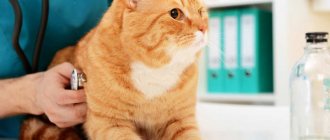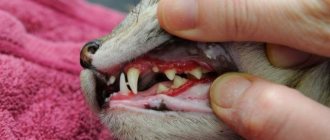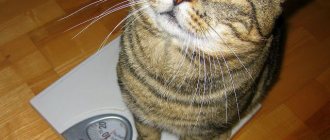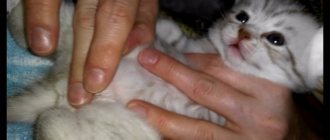The quantity, quality and frequency of urine excreted is the most important indicator of the health of a cat. It’s good when owners control their pet’s trips to the litter box. This will allow you to promptly detect that there is something wrong with the animal’s urinary system.
We will look at how many times a day a cat should pee, we will name the symptoms and possible causes of deviations from the norm, methods for identifying and eliminating pathologies, and we will also tell you how to prevent problems associated with impaired urination.
Features of the urinary system of cats and cats
There is nothing special in the structure of the kidneys, ureters and bladder of these animals, with one exception. The kidneys of cats are supported by very long ligaments, so they constantly change their position, like the wandering kidney in humans. This is a pathology only for humans, and mobile cat kidneys do an excellent job of producing and filtering urine.
Another thing is the urethra (urethra). In cats, this hollow tubular organ is quite short and wide. Its diameter allows you to painlessly remove sand and small stones, preventing blockage of the urinary tract.
The male urethra is long and thin, and along its length there are numerous narrowings (stenoses). In addition, it has an S-shape, which makes urination even more difficult.
Normally, the body of pets of both sexes excretes from 50 to 200 ml of urine per day, this depends on the size and weight of the animal. Now we’ll find out how many times a day a cat should pee.
When do kittens pee on their own?
Newborn kittens are helpless. They are born with their eyes closed and ear canals closed, making them virtually blind and deaf during the first few weeks of life.
In fact, very young kittens depend on their mothers for almost everything, and toileting is no exception. When the kitten is very small, the mother cat will lick it to stimulate urination and defecation.
© shutterstock
Why do cats pee more often?
When a cat goes to the toilet only twice a day, this is normal. If the animal is healthy and the cat is not overfed, the bladder is completely emptied and refills within 12 hours. If a cat is “walking” or carrying offspring, it may go to relieve itself more often, but this is a temporary phenomenon.
Sterilization has no effect on how many times a day a cat pees. At the end of the recovery period, urination is normalized to 1-3 times a day.
The long, tortuous urethra does not allow cats to completely empty themselves in one go. Neutered pets and stud cats visit the litter box at least 3-4 times a day. But the latter also mark their territory, which is not regarded as a full-fledged act of urination. Also, some owners note that after castration their cats begin to pee more often. This is also considered the norm.
However, there are exceptions to every rule, and there are cats that rarely relieve themselves throughout their lives and feel great. Therefore, when wondering how many times a day a cat should pee, it is important to take into account the individual characteristics of the animal and the conditions under which it is kept.
When deviations from the norm are safe
If an animal consumes dry food, its water consumption increases and, accordingly, urination becomes more frequent. In castrated cats, the number of urges increases. Perhaps in this way the pet’s body dilutes the urine and prevents the formation of stones.
After surgery, cats may not go to the toilet at all. If they feel satisfactory, urinary frequency is restored after 3-5 days. For a cat, the process can take up to a week.
Changes in the frequency of urination may change when the temperature in the room increases or decreases, moves to another place of residence, or while traveling. If a change in the frequency of trips to the litter box is not accompanied by pathological symptoms, there is nothing to worry about.
Source
What affects the process of urination in cats?
Animals, like people, are all very different. Some cats have been lazy and lazy since childhood, while others jump around in closets until old age. Among the cats there are little-eaters and gluttons, water-drinkers and those who drink very little. From here a number of patterns can be traced in the process of urination:
- Cats that eat little and sleep most of the day can go to the litter box once during the day and once at night.
- Lazy cats can endure for a long time in order not to make unnecessary movements, so they accumulate urine and pee rarely and a lot.
- How many times a day a cat should pee is known to the owners of active and active animals. Their pets will not tolerate it, they go to the toilet as needed, and if they often touch a bowl of water, they can go to the litter box up to 6 times a day.
And if a cat goes to the toilet in this mode all his life, then this is normal. As animals age, the number of acts of urination may gradually decrease or, conversely, become more frequent. This is due to the natural aging of the body and inhibition of urination function.
If in a short period of time a cat begins to pee less often or more often, or the amount of urine excreted has noticeably decreased or increased, this may be one of the symptoms of a disease, not necessarily of the urinary system.
Reasons for deviations from the norm
Deviation of the frequency of urination from the norm can be due to both external conditions and physiological factors, and pathological reasons.
Physiological (diet, external conditions)
Cats are emotional creatures, so they react acutely to changes happening around them. A move, a change in diet, the owner's departure, a trip to the clinic, the appearance of a child or another animal in the house, and other stressful situations can cause a cat to visit the litter box more often or less often than usual. This is due to a reflex contraction of the bladder muscles against the background of psycho-emotional stress. Stress is also indicated by increased licking, changes in appetite, and atypical behavior. Restoration of urinary function usually occurs within 3 days.
Reducing the number of trips to the toilet in small ways may be associated with a change in diet. When switching from dry food to wet food or to natural food, the need for liquid decreases, and the number of acts of urination also decreases. A cat may urinate little on hot days. If he doesn't drink enough water, dehydration sets in and the number of visits to the litter box decreases.
Pathological (diseases)
The most common reason that a cat does not pee a lot is urolithiasis. The pathology is characterized by the formation of hard deposits in the form of sand or stones in the kidneys, bladder and urinary tract. It is accompanied by the following symptoms:
Most often, urolithiasis affects cats due to the narrowness of the urethra. The development of the disease can be genetically determined or provoked by unfavorable factors - excess weight, passive lifestyle, poor quality nutrition, hormonal imbalance, malfunction of the digestive tract.
Cystitis is the most common disease of the genitourinary system in cats. When the bladder is inflamed, the animal pees little, but visits the litter box more often than usual, since the outflow of urine is difficult. Due to the painful process, it may meow pitifully. The appearance of urine changes - it becomes darker, becomes cloudy, takes on the smell of ammonia, and may contain blood and pus. The pet's belly is swollen and painful. In the acute form, fever may occur.
The reason for rare visits to the litter box may be kidney diseases, characterized by renal failure, including cancer. The organ fails to cope with its function and produces less urine or does not produce it at all. In the first case we are talking about oliguria, in the second – about anuria. Toxins are not removed from the body and intoxication occurs. The pet is weak and apathetic, refuses to eat, the pulse quickens, and the mouth smells of urine. He suffers from vomiting and diarrhea, and in advanced cases, tremors and convulsions.
In addition to kidney disease, anuria can be caused by infections, cardiovascular failure, tumors and injuries that lead to blockage of the ureters. Oliguria and anuria are life-threatening conditions that require immediate veterinary attention.
Another reason for infrequent urination is urinary tract obstruction. In the vast majority of cases it affects cats. Sometimes blockage is caused by stones and grains of sand that enter the urethra from the bladder. It can also be caused by spasm of the urethra or inflammation of its walls, leading to swelling and blocking the flow of urine. Another cause of obstruction is malignant neoplasms compressing the ureter.
Rare visits to the toilet by a cat may be associated with infection - chlamydia or mycoplasma. These microorganisms can infect many organs, including the kidneys, bladder and ureters. In this case, problems with urination occur. A sick animal is lethargic and apathetic, eats little and sleeps a lot. Sometimes other symptoms appear depending on the location of the infection.
Another cause of problems with urination is helminthic infestations. Typically, parasites find refuge in the animal’s intestines, but through the bloodstream they can enter the organs of the genitourinary system, leading to disruption of their functioning and provoking spasms that lead to difficulties with urination.
When to sound the alarm
Violation of the process of urination and its frequency after some time is accompanied by other signs of the development of pathological conditions. Therefore, it is important to pay attention to how many times a cat pees, the quality of its urine and the general condition of the animal. Owners should be alarmed by the following signs:
- cloudiness and change in the color of urine (instead of light yellow - orange, brown, the color of meat slop, or, conversely, colorless);
- a swollen or hard, tense abdomen, when stroking the cat reacts painfully or aggressively;
- the pet misses the tray and pees intensely;
- strong thirst appeared for no apparent reason;
- the appetite disappeared, the cat became lethargic or, conversely, restless.
The first sign of the development of many pathologies in cats is just a change in the quantity and quality of fluid secreted, which is why it is so important to monitor how many times a day a cat pees. Felines are one of the hardiest animals, and deterioration in their general condition often manifests itself only against the background of chronic processes.
When do kittens pee in the litter box?
Kittens largely learn to use a litter box when they begin to urinate and defecate on their own, around 3-4 weeks of age. This process is actually quite unusual as it is based on both instinct and observation.
Kittens have a natural instinct to scaveng on the ground or sand. This instinct is very primitive and goes back to the wild ancestors of our kitten, who peed only in those places where they could subsequently actively hide their smell.
Our pet kittens still retain this instinct, and by providing them with a litter box, we give them the perfect place to pee!
Kittens also watch their mothers closely and learn to use the litter box simply by watching. Most cat owners will never need to formally "train" their kitten to use a litter box because by the time they arrive at their new home, they will likely have been doing it for several weeks.
One of the few times kittens won't want to use the litter box is if they are disabled or have arthritis.
Causes of urinary dysfunction
A pet’s illness is a difficult ordeal for both it and its owners, but many problems with the animal’s health can be avoided. Let's consider the most common causes of the development of pathologies and their consequences:
- Overfeeding and obesity often lead to the development of diabetes. In this case, one of the clinical manifestations is frequent, copious painless urination, and sometimes urinary incontinence.
- An unbalanced diet, cheap food, fish in the diet, poor quality water, and a sedentary lifestyle provoke urolithiasis. Urination becomes frequent, painful, mixed with blood, or there may be a complete absence of urine while the urge persists.
- Hypothermia, stress, stagnation of urine, stones, and ureteral infections cause the development of cystitis. The first sign of bladder inflammation is very frequent, almost futile trips to the toilet.
- Vitamin B6 deficiency, helminthic infestations, and disturbances in the outflow of bile can cause cirrhosis of the liver. A striking clinical manifestation will be the orange color of urine excreted in large portions, often past the tray.
If you do not constantly monitor how many times a day your cat pees, it is easy to miss the manifestations of inflammatory kidney diseases, for example, pyelonephritis or glomerulonephritis. By the age of 8, the chronic form of the pathology turns into renal failure. The cat begins to drink a lot, go to the toilet up to 10 times a day, the urine becomes colorless and odorless.
Cats are not only very hardy, but also extremely patient, and a pet screaming in pain is actually an extremely rare occurrence. This often misleads owners and gives the false impression that everything is fine with the animal. Therefore, changes in the nature of urination should be an important reason for owners to show the cat to a specialist.
Impaired formation of feces
Short-term diarrhea may be caused by changes in feeding composition, stress or overeating. If you have one-time loose stools, you do not need to go to the clinic. But if diarrhea continues for several days, then you should contact a specialist.
Main causes of diarrhea:
A sudden change in diet. New feeds and individual components should be introduced gradually.- Inappropriate feed composition. Sometimes pets, due to the characteristics of their bodies, do not digest certain foods well. The problem can be solved by reviewing and adjusting the diet.
- Poor quality feed.
- Metabolic disease.
- Worm infestation. Toxins and waste products of worms lead to poisoning of the animal’s body.
Diarrhea can also be caused by neoplasms, infections, bacteria, peptic ulcers and other pathologies. To make an accurate diagnosis, you should contact a veterinary clinic. The doctor will conduct an examination and prescribe appropriate tests.
Causes of constipation:
- Excess protein in the diet.
- Dehydration of the body. Usually develops when feeding dry food without free access to water.
- Obstruction or blockage of the intestine. For example, bloat, tumor, hairballs or worms.
- Decreased activity.
- Constant or severe stress.
Before diagnosis, the animal should not be given laxatives. Increased intestinal motility due to blockage can lead to the death of the pet. If constipation persists for 2–3 days, you should consult a veterinarian.
What should be done in case of deviations from the norm?
Prolonged violation of the litter tray requires urgent contact with a veterinarian. First of all, it is necessary to establish the cause, and then carry out treatment.
Most deviations from the norm can be treated by adjusting the diet. But some diseases require urgent intervention and long-term therapy.
Diagnostics
An experienced veterinarian can make a preliminary diagnosis simply by examining the pet and talking with the owners. He will definitely ask how often the cat pees. However, in most cases, one or more diagnostic measures are required:
- urinalysis is an important study that allows you to detect changes in the pH and density of urine, sand, salts, protein, glucose;
- biochemical blood test is a highly informative diagnostic method that determines the condition of internal organs and systems;
- Ultrasound of the abdominal organs is now practiced in most veterinary clinics for the timely detection of infectious, inflammatory and tumor diseases.
Based on the diagnostic results, the doctor prescribes treatment. It is necessary to fight for the animal, especially since modern veterinary medicine has all the necessary means for treatment.
A little about surgical castration
Since this technique is the most common and “typical”, it is necessary to describe it first. Immediately before the procedure, the veterinarian must take all types of tests from the cat in order to understand whether the pet has any systemic diseases or infectious pathologies in which castration is unacceptable.
Based on the data obtained and taking into account the physiological state of the pet, the specialist must decide what type of anesthesia to use in this case: general anesthesia or local anesthesia. As a rule, local anesthesia is used only in the case of very young animals.
Today, experts are increasingly inclined to believe that general anesthesia is necessary for any type of surgical castration.
It is precisely because of the widespread use of general anesthesia that cases of “inappropriate” behavior in sterilized pets are becoming increasingly common. Coming out of anesthesia is a long process and not every cat’s body is able to cope with it quickly. Some cats come to their senses only at the end of the third day (but this still happens rarely).
Treatment
It is clear that in each case, therapy is prescribed individually, but we can consider the general principles of treating cats for the most common diseases:
- For urolithiasis, antibiotics and antispasmodics are prescribed, and a urinary catheter may be installed. When the urinary tract is blocked by stones, surgery is performed.
- To treat cystitis in cats, antibiotics and diuretics are used in the form of injections and droppers.
- In case of liver damage, the water balance in the body is first restored, then hepatoprotectors are prescribed.
- With diabetes, some cats remain insulin dependent for life, while the health of others is maintained by glucose-lowering medications.
Following the doctor's recommendations, many owners literally pull animals out of the dead. The veterinarian will tell you how many times a day a cat who has suffered a serious illness should pee, and will certainly prescribe a diet. And this is an important preventive measure to prevent the development of dangerous pathologies in cats.
How addiction is formed
Anyone can become addicted to alcohol: you don’t have to drink strong alcohol to do so. The body reacts to any ethanol-containing drink - alcohol poisoning occurs. Over time, physical cravings develop. The blood alcohol level is the same whether it is 100 grams of vodka or 2 liters of beer.
For each person, the maximum dose of ethanol is individual. The manifestation of the disease is loss of control over drinking. At the same time, there is no critical perception of one’s state when drinking alcohol.
Over time, natural biochemical processes change. Physical cravings are formed when a person constantly needs ethanol. However, this does not happen immediately, but after the onset of psychological dependence. Initially, drinking is needed to overcome complexes or in an attempt to cope with problems or relieve stress. Over time, such a solution becomes the only acceptable one.
Without the opportunity to drink, a person’s mood and well-being worsen. Therefore, the frequency of drinking alcoholic beverages and the dose of ethanol are increasing. The craving for alcohol becomes out of control and pathological. All new doses are needed to overcome withdrawal symptoms, while the pleasure from drinking becomes less and less. The emotional reaction to alcohol-containing drinks changes.
Prevention
The incidence of urolithiasis in cats is five times higher than in cats. This disease is one of the most frequently diagnosed after helminthic infestations.
Proper metabolism prevents the formation of stones, so a balanced diet is the key to health, especially when it comes to castrated and sterilized cats. These are truisms, but owners, even when buying premium food, do not comply with the feeding standards indicated on each package, so they mix the finished product with natural food.
Lack of water is one of the reasons for the formation of urate stones, and since cats have a poorly developed sense of thirst, there is a good way to teach your pet to drink more. Place several different vessels with water in different places in the house, this invariably arouses interest in the animals and a desire to try.
Protect your cat from hypothermia. Don't let him sit on a freshly washed floor until it's dry, and don't let him sleep on the floor under an open window. And, of course, watch how often the cat pees. This is the most important marker in home diagnostics of a pet’s health condition.
What is castration?
Although it is generally accepted that this term refers exclusively to the surgical removal of the testes, in fact this is not entirely true.
“Castration” itself is the suppression of the sexual function of an animal, and for this it is not at all necessary to remove the gonads.
Today there are the following types of sterilization that are actively used in practice:
- Surgical castration. The most common option. Involves surgical excision of the testes.
- Radiation. The gonads are irradiated under a directed source of gamma radiation. The glandular tissue that makes up the testicles is very sensitive to radiation. Its cells quickly die and are subsequently replaced by connective tissue. The cat's libido, accordingly, drops.
- Chemical castration. With this method, chemicals are introduced directly into the tissue of the testes, promoting tissue degradation and “drying out” of the organs. This technique is not very common in our country, but in Asian countries where it is widely practiced, a 10% calcium chloride solution is used for this purpose.
- Medical castration. In this case, a cartridge with special medications is sewn under the cat’s skin. Gradually released into the general bloodstream of the animal, they suppress its sexual function. The advantage of this type of castration is not only its simplicity. When the medicine in the cartridge runs out, the pet's libido gradually returns. So this method can be used for temporary castration. This is relevant, for example, for cat owners who often travel abroad with their pet.
To understand what exactly can cause a cat’s inappropriate behavior after the procedure and what to do about it, you need to have at least an approximate idea of exactly how it is carried out.









